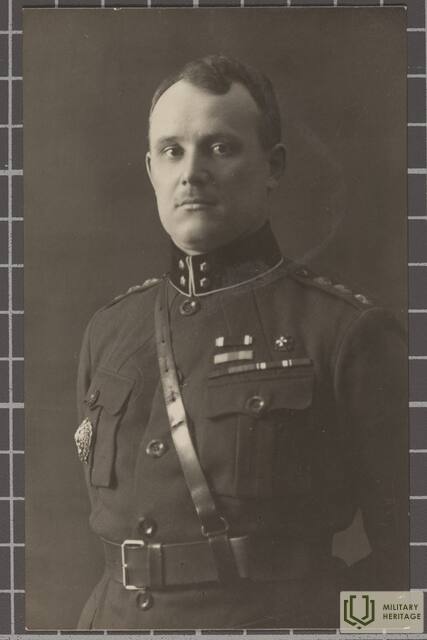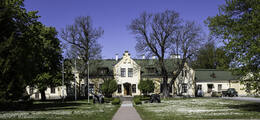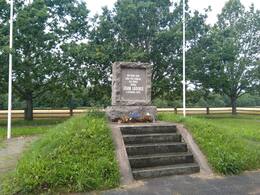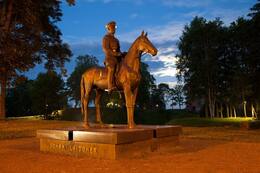Johan Laidoner (1884-1953) I Wars of Independence
Estonian general and politician, Commander-in-Chief of the Estonian Armed Forces during the Estonian War of Independence. Cross of Liberty 1st Class 1st Rank and 3rd Class 1st Rank recipient.
Johan Laidoner was born on 12 February 1884 in Viljandi County. In 1901, having come from a poor family, he voluntarily joined the Imperial Army at a young age. He went on to study at the Vilnius Junker Infantry School from 1902 to 1905, graduating top of his class. He was promoted to the rank of junior lieutenant and was sent to serve in the 13th Yerevan Grenadier Regiment. In 1908, he was promoted to the rank of lieutenant.
From 1909 to 1912, Johan Laidoner studied at the Imperial Nicholas Military Academy in Saint Petersburg and went on to pursue a military career by participating in the First World War. Having been promoted to the rank of lieutenant colonel, in 1917 he was called upon to assume the position of Commander-in-Chief of the newly formed Estonian regiments – Head of the 1st Estonian Division.
At the outbreak of the War of Independence, the Estonian Provisional Government promoted Laidoner to the rank of colonel and appointed him Commander-in-Chief of the Estonian Armed Forces on 23 December 1918. It was he who led the Estonian Armed Forces to victory in the War of Independence. In 1919, he was promoted to the rank of major general. After the War of Independence, he was promoted to the rank of lieutenant general and retired. In 1923, Johan Laidoner was given Viimsi Manor in recognition of his contribution in the War of Independence, which now houses the Estonian Military Museum – General Laidoner Museum.
After the war, Laidoner entered politics and served as a member of parliament from 1920 to 1929 and a member of the Estonian delegation in the General Assembly of the League of Nations from 1922 to 1929. After the failed communist coup d'état on 1 December 1924, the government declared martial law throughout Estonia and Laidoner was called back to serve as Commander-in-Chief of the armed forces for a while.
After the coup d'état in 1934, Laidoner was again appointed Commander-in-Chief until his dismissal on 22 June 1940. He was promoted to the rank of general in 1939.
Soviet authorities arrested Laidoner on 19 July 1940. He died on 13 March 1953 at the Vladimir Central Prison in Russia.
His wife Maria, née Kruszewska (1888-1978, deported in 1940, released in 1961), son Michael (1913-1928), stepson Aleksei Kruszcewsky (1913-1941, deported, died in prison).
Related objects
Estonian War Museum - General Laidoner Museum
This museum, which has been housed in the mid-19th century historicist Viimsi Manor since 2001, conducts research into and both preserves and displays Estonian military history. Its predecessors were the Estonian War of Liberation Museum (founded on 19 January 1919) and a museum dedicated to General Laidoner established at the manor by decree of Viimsi Municipal Government in 1993. During the Soviet occupation, the manor was used by a naval intelligence unit: after the withdrawal of the Soviet Army, the building was in a dire state. The museum was founded by decree of Minister of Defence Jüri Luik on 26 February 2001. Since then, the museum has operated under the jurisdiction of the Ministry of Defence. Its main exhibition showcases wars fought in Estonia and abroad in which Estonians have participated. Part of the exhibition is dedicated to Commander-in-Chief Johan Laidoner, who owned the manor from 1923-1940. The military equipment hangar near the main building displays a variety of artillery pieces and vehicles.
Place of Birth of General Johan Laidoner
The farmhouse on Raba Farm in the village of Vardja, where General Laidoner was born, has not survived. It is thought to have been destroyed before World War II, as a monument was erected in its place in 1937. The monument was demolished in 1940 and restored in 1990. In recent years people have been regularly placing candles at the old farmstead on the general's birthday, 12 February.
Monument of General Johan Laidoner
The equestrian statue of General Johan Laidoner is situated near the castle hills in Viljandi.
This monument, designed by sculptor Terje Ojaver, was unveiled in 2004.
Dedicated to Commander-in-Chief General Johan Laidoner, it was the first and to date remains the only equestrian statue in Estonia. The prominent military man and politician, who was born in the county, was the first honorary citizen of Viljandi.
Related stories
The beginning, course and conclusion of the Battle of Cēsis
The victory in the Battle of Cēsis was destined to become a turning point in the Latvian and Estonian struggle for the independence of their country. This victory put an end to the plans of the Andrievs Niedra government and the German general Rüdiger von der Goltz to conquer the Baltics. Instead, the Latvian Provisional Government of Kārlis Ulmanis resumed its activities in Liepāja.








